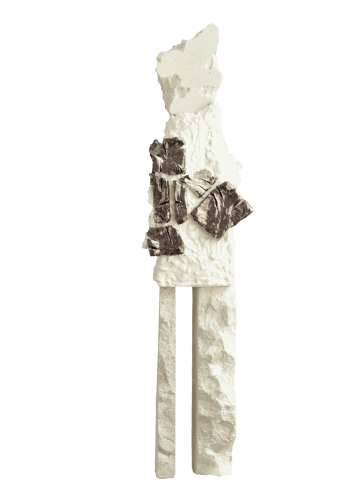“For me, identity and origins are fiction. A fiction that each one of us tells in our own way, from personal and accumulated history, the tales that run within. Uncannily, we could reduce my work to a quest for origins, or even mankind’s origins. But THERE ARE NONE. My work is an attempt to deal with the hollowness, the whole, the impossible. Origins and identities are, by nature, impossible in themselves: impossible to say, impossible to write, impossible to show”. (Léo Nataf).
From October 11th to November 15th, 2022, the exhibition “Origin(s)?”, at 41 Dover Street, London, will present the sculptures of Léo Nataf, represented by Millenn’Art.
“Origin(s)?” was born from the father-daughter collaboration between Daniel and Annabelle Cohen-Boulakia, who share in their desire to present the work of French artist Léo Nataf. The exhibition will display a set of sculptures that highlight the artist’s relationship between his body and the materials he works with.
Born in 1994, Nataf is a young French sculptor who graduated from the prestigious Central Saint Martins art school in London. He now works from his studio in Saint-Denis, a commune in the northern suburbs of Paris. His first solo show was produced by Millenn’Art in November 2021, in collaboration with Clavé Fine Art, in Paris.
“To know, is to know through causes. To understand, is to go back to the origins. In the forest, in the savannah, on the sea, in the desert sands, the beginning of beginning, the start of everything, is the major myth of Mankind.” (Jean D’Ormesson, C’est une chose étrange à la fin que le monde, 2010).
Imagining and interpreting civilisation at its dawn is the predominant focus of Nataf’s artistic oeuvre. Through his extensive travels across Papua New Guinea, Ethiopia, Mesopotamia, Mexico and the Amazon, Nataf is continuously inspired by the places he visits and the people he meets, whilst learning about himself along the way.
A head, a chest, two legs. Through his “Guardians” series, Nataf attempts to interpret his view on what could have been man’s first sculptural self-portrait. This historical figure is at once faced with conflict, placed in a paradox between chemical materials such as aerated concrete and enamel, and more natural elements like ceramic and pigments. Nataf’s opposing use of
medium in the realisation of these figures reflects their very essence. These guardians, seemingly strong and imposing, are instead fragile and unstable, demonstrating their fading, obscure and untraceable story.
Nataf’s artistic process is quite original. Earthly matter, like ceramic, stone, and wood, are mixed with artificial elements, like foam, or aerated concrete, ultimately creating a whole, in which the origins of all substances, organic and man-made, are blurred. His spheres are a means of exploring the foundations of origin, linking humanity and material together. By using fire in the construction of his spheres, he burns his elements, blending them to make one. The spheres are composed of different mediums such as ceramic, wood, foam, pigments and volcanic stone. These organic substances are meticulously selected, dependent upon the environment of the artist. During his residency in Mexico in 2020, Nataf discovered the potential of volcanic stone as an artistic medium. Unlike the other elements, this rock resists fire. In this medium, the artist views the unwavering resistance to the intensity of the flame as a passage to the discovery of origins.
At the same time, the artist uses his body. He carries, he scratches, he destroys. Nataf maintains a constant need to feel the elements he works with. The idea that Mankind dominates Nature is reconstructed, as the artist allows his elements to exist autonomously, submitting himself to their own transformations. Through this, accident becomes an integral part of his work, as the dominant/dominated relationship is reversed. The artist, humble and observant, is now passive, while the material is creative.
Nataf’s works are permeated with countless stories and beliefs. He calls upon various cults of ancient civilizations in his “Sphynx” piece, employing animals as a link between the secular and the sacred.
Then, the artist comes to question his own origin... where does he come from?
The transmission, whether it is of religion or tradition, is essential for Nataf, who carries the torments of a shattered past, marked by the atrocity of Shoah, and the exiled and identity disputes of North African populations.
“If I were from a Berber tribe, the Berber would not recognize me”. (Albert Memmi, La statue de sel, 1953).
Emerging from this fragmented post-colonial world, as described by Tunisian author Albert Memmi, Nataf confronts his ancestor’s stories, listening, observing, learning and feeding off them, just like his approach to artistic medium.
The new guardians, designed on human scale, can be regarded as a manifestation of Nataf’s own origins. Sahara’s marble and Iranian stone reflect his SWANA’s (Southwest Asia and North Africa) origins, where Hainaut’s blue stone alludes to those of Eastern Europe.
The exhibition “Origin(s)?” therefore embodies the tangible issues of identity, ultimately revealing its limits, as material comes to trace the symbols of history.
